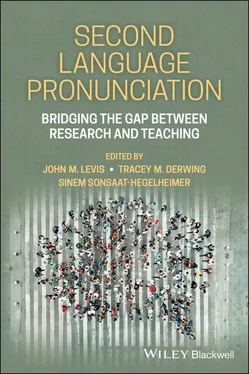Second Language Pronunciation
Здесь есть возможность читать онлайн «Second Language Pronunciation» — ознакомительный отрывок электронной книги совершенно бесплатно, а после прочтения отрывка купить полную версию. В некоторых случаях можно слушать аудио, скачать через торрент в формате fb2 и присутствует краткое содержание. Жанр: unrecognised, на английском языке. Описание произведения, (предисловие) а так же отзывы посетителей доступны на портале библиотеки ЛибКат.
- Название:Second Language Pronunciation
- Автор:
- Жанр:
- Год:неизвестен
- ISBN:нет данных
- Рейтинг книги:5 / 5. Голосов: 1
-
Избранное:Добавить в избранное
- Отзывы:
-
Ваша оценка:
- 100
- 1
- 2
- 3
- 4
- 5
Second Language Pronunciation: краткое содержание, описание и аннотация
Предлагаем к чтению аннотацию, описание, краткое содержание или предисловие (зависит от того, что написал сам автор книги «Second Language Pronunciation»). Если вы не нашли необходимую информацию о книге — напишите в комментариях, мы постараемся отыскать её.
Second Language Pronunciation: Bridging the Gap Between Research and Teaching
Second Language Pronunciation: Bridging the Gap Between Research and Teaching
Second Language Pronunciation — читать онлайн ознакомительный отрывок
Ниже представлен текст книги, разбитый по страницам. Система сохранения места последней прочитанной страницы, позволяет с удобством читать онлайн бесплатно книгу «Second Language Pronunciation», без необходимости каждый раз заново искать на чём Вы остановились. Поставьте закладку, и сможете в любой момент перейти на страницу, на которой закончили чтение.
Интервал:
Закладка:
Contrastive Stress
Levis and Muller Levis (2018) conducted an experiment with learners of English with a focus on contrastive stress. Over a three-week period, the instructors provided explicit instruction regarding contrastive stress (e.g., pointing out “lexicogrammatical patterns that are used to compare and contrast (e.g., other, first/second, on the left/right )” (p. 149) and offered auditory examples. Students practiced by producing sentences based on pictures that differed (e.g., two houses with different sizes, colors, number of stories, and number of windows, examples of which are available in their open-access publication). Pre- and post-picture descriptions were recorded, and were the basis of a listening study in which 20 undergraduate students rated the descriptions for comprehensibility and fluency from the experimental group and a control group on 9-point scales. The authors found that comprehensibility was improved in the experimental group, although fluency did not change in either group. A simple focus on contrastive stress over a relatively short time period made the speech of these learners easier to understand.
Sitcom Cycle
For many years, expert practitioner Janet Goodwin used clips from sitcoms to aid her students’ awareness of English pronunciation (for details, see Goodwin, 2005). She would take a scene from a popular TV show, such as Seinfeld or Friends , and would ask her students to break into small groups and transcribe the segment. This required multiple listenings. She then had the students mark word stress and major intonation patterns, getting them to focus on prosody. Again, this took multiple listenings. After each of these rounds, she went through the clip with the students, correcting any errors and asking them to listen again to confirm that they could perceive the productions accurately. The next step was to have the students perform the scene, incorporating the body language used by the characters, and using their marked transcriptions as the script. This arc of activities serves several purposes. First, students tend to accept sitcom language as “real” speech, despite the fact that it is scripted, and therefore tends to be more grammatical and coherent than actual “real” speech. The multiple listenings, first for general understanding (transcription) and next for prosody, offer the learners the repetition they need, but with an achievable goal. The teacher can flag areas of difficulty and do some extra work on those areas before moving on. The performance aspect of the activity is carried out only after the learners have heard the clip many, many times, in the company of their classmates. Thus, it is nowhere near as threatening as a speaking activity that is imposed out of the blue. Goodwin video-recorded the learners’ performance, and the whole class would then comment on the strengths and areas for improvement. This intensive focus on a short (2- to 3-minute) clip can lead to significant awareness raising and improvement in production. Goodwin’s activity entails a great deal of recycling of the same material. Repeated passes at the same activity for different purposes can be highly beneficial.
Jazz Chants
Another old, but useful, resource is Jazz Chants (Graham, 1978), which can be employed quite differently from the author’s original intention, which was a focus on grammar in spoken English, along with affective intonation. Prosodic elements can be practiced by going through a chant once with the learners listening, and then having them listen again and tap or clap the beats. The instructor can then substitute a single syllable such as “da” for all of the syllables and have the students first listen and then repeat the chant, using “da” throughout (this eliminates any struggles with consonant clusters or other segmental difficulties, which should not be the focus of a prosodic lesson). The students can be asked to count the number of syllables in each line, and then count the number of stressed syllables. For some learners it is a surprise to find that lines that are meant to be of equal length can vary by several syllables yet share the same stress pattern. Several Jazz Chants are available on the internet for teachers who may not be able to access the printed resource, or who are unsure as to the rhythm of each chant.
TED Talks
McGregor et al. (2016) pointed out that most pronunciation textbooks treat intonation in a mechanistic way that belies its relationship to context. They chose to analyze aspects of intonation (prominence, salience, tone choice) employed in a Ted Talk using both a perceptual analysis (thought groups, pitch changes, etc.) and an interpretive analysis, examining given and new information, speaker’s perceived attitude toward content, and speaker’s perceived attitude toward audience. Ted Talks are generally recognized as informative monologues presented with the intent to persuade and educate in an effective manner, and are exemplars of successful communication. Speakers make an overall impression on their listeners not only through the content of what they say, but how they say it in real time. McGregor et al. showed in this study that intonation conveyed the speaker’s attitude toward both the content and the audience – thus it carried meaning that goes far beyond the typical atomistic treatment of intonation in pronunciation texts (e.g., raise pitch at the end of a yes/no question). Intonation, they argue, contributes to meaning-making in a holistic way and should be taught as such. They suggest bringing students’ attention to the general impression created by the speaker, followed by an examination of how that impression was developed by examining the structure of the talk.
Readers Theater
Tanner and Chugg (2018) adapted a technique long used to develop reading skills to enhance oral fluency. As the authors point out, Readers Theater does not require props, costumes, or even much bodily involvement. The authors developed four scripts suitable for young adults (“academic honesty, finding a job, ways of travel, and modern innovations” pp. 187–188) and invited intermediate level ESL students enrolled in a 14-week program to engage in scripted performances. A comparison group received standard classroom practice. Prior to the implementation of Readers Theater, the classroom teacher introduced some basic tenets of pronunciation, including the role of pausing, word and sentence stress, and pitch changes. The students spent three weeks on each of the four scripts, and the teacher provided regular feedback on their communicative success. At the end of the term, the learners reported that their self-confidence and their fluency had improved. General language proficiency pre- and post-tests showed that both the comparison and experimental group improved significantly, and that the two groups did not differ. The authors recommend further research to determine if the speaking of the Readers Theater learners improves in comparison to a control group, but given the very positive increase in self-confidence, and the enjoyment factor, they recommend the inclusion of Readers Theater going forward.
Drama
Moving beyond Readers Theater, Galante and Thomson (2017) conducted an experiment to determine whether the inclusion of drama in ESL classrooms would improve learners’ comprehensibility, fluency, and accentedness. Although drama can include scripted elements, it also extends to improvisational roleplays. The authors worked with four low intermediate classes, two of which comprised a Comparison group who followed a standard communicative program incorporating pair and group work but no drama activities. The experimental classes undertook a wide range of drama activities and ultimately wrote and performed their own play at the end of term.
Читать дальшеИнтервал:
Закладка:
Похожие книги на «Second Language Pronunciation»
Представляем Вашему вниманию похожие книги на «Second Language Pronunciation» списком для выбора. Мы отобрали схожую по названию и смыслу литературу в надежде предоставить читателям больше вариантов отыскать новые, интересные, ещё непрочитанные произведения.
Обсуждение, отзывы о книге «Second Language Pronunciation» и просто собственные мнения читателей. Оставьте ваши комментарии, напишите, что Вы думаете о произведении, его смысле или главных героях. Укажите что конкретно понравилось, а что нет, и почему Вы так считаете.












